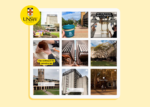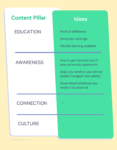BLOG
Social Media Content Pillars: What are they, and why are they so important?
Do you feel like you’re constantly posting on your social media accounts at the last minute and struggling to come up with things to post? Content pillars can help!
So, what are content pillars in social media?
Content pillars are generally three to five topics or themes that form a foundation for a successful content marketing plan. These pillars support your digital marketing strategy’s overall objectives and help you connect with your audience in an authentic and meaningful way.
Having the right content pillars in place also ensures that your efforts are spread evenly across all objectives and milestones your business may have, from awareness and lead generation to conversion. Without content pillars, your content is likely to lack direction, leading to lower reach, engagement, and brand recognition.
What are examples of content pillars?
For example, if you are a university, you might choose the following content pillars:
- Education
- Awareness
- Connection
- Culture
From here, you can brainstorm content ideas relevant to each pillar and platform, like this:
Education
- Instagram Reel: get a current student to talk about what makes their university different to others (point of difference)
- Facebook carousel of images: each image/social tile provides a benefit that their flexible learning options provide (can fit studying into your lifestyle)
Awareness:
- Facebook video: student or teacher to give their top five mobile phone apps that all students should have (public transport and safety)
- TikTok: student gives three tips on how to get the most out of your university experience
And so on!
Want to see examples of universities that are nailing their social media content? Here are a few:
Liberty University does a great job providing student-centred content which stays true to their unique values, encouraging followers to feel part of the community.
The University of New South Wales
University of New South Wales hones in on UGC-style video content to paint an immersive picture of student life, from highlighting the best spots to study to quick-fire campus tours.
University of Queensland uses Instagram to full effect, showing off their stunning campus and Queensland’s cities. Purple hues are weaved throughout, helping to create a strong connection between the brand and content.
Pro tip: if you’re not 100% sure what your content pillars should be, go back to basics.
What are your brand’s key goals or mission statement? By going back and rereading these, you should get a clearer idea of what your brand’s identity, purpose, tone of voice and positioning are on social media.
How can content pillars be used in marketing?
Once you have established what content you want to highlight under each pillar, you can go one step further and decide which platform best suits each idea and what asset you would like to use, ensuring that you use each platform to its full advantage.
For example, regarding the education pillar and what makes you stand out from others, you could create a Reel for Instagram with a student talking about why they chose to study at your university. This same idea could be broken down into a carousel of images for Facebook, with each image highlighting another reason to choose your university.
Also, if people follow you across multiple social media platforms, you don’t want them to be delivered the same content when flicking from Instagram to Facebook. Tweaking the caption and assets used can make all the difference!
Why are content pillars important?
- Relevant content is best.
Instead of creating posts and assets on the fly, content pillars help you create a calendar that covers all relevant content for your brand. - Keep everyone on track with a plan.
Having distinct themes you want to hone in on also makes it much easier for you to plan your posting calendar strategically. - Speak to your whole audience.
Defined pillars serve as a guide for crafting specific content for specific people, so you’re not ignoring one whole section of your audience. - More time for ideation.
Content pillars allow you to spend less time worrying about posting for the sake of posting and more time finding ways to deliver stellar content around specific themes or topics—quality over quantity.















